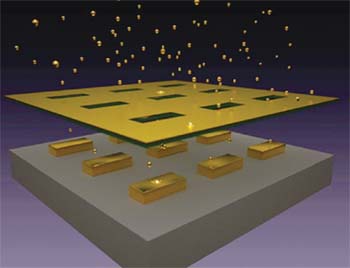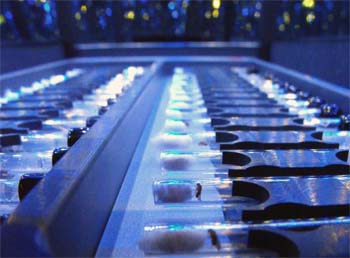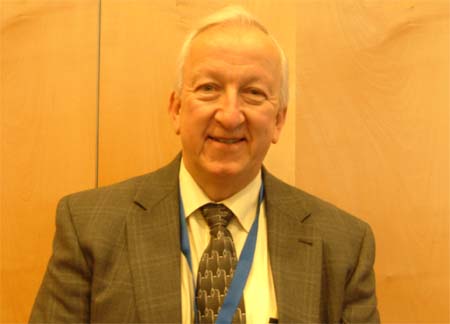La semana pasada, nos reunimos con el Profesor Dr. Robert Karlicek, el Director del Smart Lighting Engineer Research Center en el Rensselaer Polytechnic Institute. Científico encantador y atento y un excelente comunicador, Karlicek amablemente accedió a ofrecernos una entrevista en exclusiva para nuestros lectores antes del evento Smart Lighting 2014. Sus ojos brillantes y profundos transmiten la pasión de un investigador de primera clase totalmente involucrado con su actividad, ávido de novedades impensables y aún así con los pies en la tierra. Karlicek nos ofrece una visión general de las áreas en las que está trabajando.
Descripción del Centro de Investigación en Ingeniería (ERC)
El concepto de Centro de Investigación de Ingeniería (ERC) se inició hace unos 26 años por la National Science Foundation (NSF) y está diseñado para trabajar desde una perspectiva a nivel de los sistemas para identificar los problemas críticos y desde esa base estudiar toda la ciencia y la tecnología fundamental que debe abordarse para llevar al mercado la tecnología. «A medida que se resuelven las barreras validamos el rendimiento y creamos los bancos de pruebas, donde los usuarios de la industria pueden participar, copiarlos o usarlos. La idea es llevar la investigación básica de la Universidad para comercializar el sistema con mucha más rapidez que en el pasado». Y  el trabajo incluye más áreas tal como nos explica Karlicek, «Nuestro Smart Lighting Engineering Research Center se centró en la iluminación en 2008 en el marco de un programa a 10 años financiado con 40 millones de la NSF a razón de 4 millones de dólares al año. NSF audita el centro cada año en las áreas de investigación, formación de estudiantes de posgrado, educación y divulgación a lo largo de todo el sistema educativo, miembros industriales actuales y potenciales, colaboraciones públicas y privadas, así como impacto en minorías marginadas, presencia global y la creación de un espíritu de iniciativa empresarial entre sus estudiantes » para que podamos poner en marcha nuevas empresas y crear nuevos puestos de trabajo». Y Karlicek añade: » Yo diría que los centros de investigación de la NSF son probablemente los programas científicos más auditados en el gobierno federal. Ahora acabamos de terminar nuestro to año y se espera de nosotros que nos «graduemos «, que para ERC significa que desarrollemos otras fuentes de financiación para continuar más allá del décimo año».
el trabajo incluye más áreas tal como nos explica Karlicek, «Nuestro Smart Lighting Engineering Research Center se centró en la iluminación en 2008 en el marco de un programa a 10 años financiado con 40 millones de la NSF a razón de 4 millones de dólares al año. NSF audita el centro cada año en las áreas de investigación, formación de estudiantes de posgrado, educación y divulgación a lo largo de todo el sistema educativo, miembros industriales actuales y potenciales, colaboraciones públicas y privadas, así como impacto en minorías marginadas, presencia global y la creación de un espíritu de iniciativa empresarial entre sus estudiantes » para que podamos poner en marcha nuevas empresas y crear nuevos puestos de trabajo». Y Karlicek añade: » Yo diría que los centros de investigación de la NSF son probablemente los programas científicos más auditados en el gobierno federal. Ahora acabamos de terminar nuestro to año y se espera de nosotros que nos «graduemos «, que para ERC significa que desarrollemos otras fuentes de financiación para continuar más allá del décimo año».
LED, línea de investigación principal
La posición de Smart Lighting ERC es que los sistemas de iluminación avanzados serán capaces de mejorar la eficiencia energética y la sostenibilidad, la promoción de la salud y el bienestar humanos, y promover la mejora de la productividad humana a través de los sistemas de iluminación de estado sólido (SSL) y de control. Pero nos preguntamos si se están desarrollando otras fuentes de luz, a lo que la respuesta es claramente LED: «Hemos decidido centrarnos en LED principalmente, no hemos estudiado la tecnología OLED u otras tecnologías. El reto del OLED está en la fiabilidad en el espectro azul y en el precio. Es mi opinión, aunque me gustaría mucho que los científicos demostraran que estoy equivocado, que este es un problema fundamental de la materia orgánica. Su energía del fotón azul y sus vínculos químicos orgánicos están demasiado cercanos en cuanto a energía de modo que la fiabilidad siempre va a verse comprometida en el espectro del azul haciendo que el conjunto del sistema no sea fiable.» Así que en el Smart Lighting ERC decidieron poner todos sus esfuerzos en los elementos de base inorgánicos como son el nitruro de galio y los fosfuros de aluminio-galio-indio.

Red integral de sensores
Sin embargo, para Karlicek, el verdadero centro de atención está en el sistema y «vemos que el futuro de los sistemas de iluminación va a estar determinado por los sistemas de control y tecnología de sensores avanzados que se basan únicamente en las placas de LED avanzadas o quizás en OLED, porque hoy todos nuestros sistemas de iluminación son ciegos, no ven donde va o rebota la luz y como resultado no pueden optimizar la iluminación para cada situación». Y Karlicek nos da el ejemplo del vestíbulo, donde estamos sentados donde entra luz natural por la ventana y pregunta » ¿Todas estas lámparas necesitan estar encendidas con esta intensidad durante el día? No, pero no pueden ver lo que está sucediendo, y como resultado estamos desperdiciando energía y no creamos el mejor ambiente para las personas’. Así que mediante la construcción de una completa red de sensores directamente integrada en los sistemas de iluminación, el sistema de iluminación será capaz de ver su entorno y de estimar sin atentar contra la privacidad de las personas, donde se encuentran éstas y lo que están haciendo y encontrar la manera de entregar la luz de calidad óptima para cualquier situación.
Comunicaciones de luz visible Li -Fi
Otra área de investigación es la comunicación de luz visible, Li -Fi, » estamos haciendo mucha investigación interesante aquí. Mucha gente todavía piensa que Li -Fi nunca va a ser una tecnología ampliamente adoptada debido a que las tecnologías de RF son tan fáciles de usar, pero el reto de las RF es que nos estamos quedando sin ancho de banda y espectro, tenemos que ir a frecuencias superiores y cuando vas a frecuencias más altas como 60 GHz se convierte en “línea de vista” que significa que tienes que ser capaz de saber dónde pararte para poder recibir la señal, porque no es transmitida». Y en ByteLight, una spin -off formada en 2011 por miembros del ERC se

dieron cuenta de que cada punto de luz era capaz de transmitir su ubicación, y cierta cantidad de datos que una persona caminando en su entorno con un dispositivo inteligente podría recibir, y dependiendo de la cantidad de luz que su dispositivo » viera», el sistema era capaz de saber dónde estaban. Se trata de un tipo de sistema de posicionamiento global de interior en el que se pueden utilizar los sistemas de iluminación y un dispositivo inteligente para moverte con un alto grado de precisión y mucho más fácilmente que con RF o sistemas de radio posicionamiento por satélite. Este sistema GPS no es realmente de alta velocidad a pesar de que es un primer paso. «Al empezar a modular la luz asegurando muy altas velocidades se pueden hacer cosas muy interesantes con el flujo de datos, la luz puede ser utilizarse como radar». Y Karlicek nos da otro ejemplo de la sala donde nos encontramos. Si el techo tuviese sensores de muy bajo coste, la luz llegaría a los objetos y enviaría la información de vuelta y el sistema de luz podría crear un mapa en 3D del espacio, podría informar de cuando se mueven los muebles, donde está sentada la gente, notificar al personal de seguridad de alertas. En resumen nos explica Karlicek » al permitir que la luz vea a una resolución que sea suficiente para proporcionar un control avanzado podemos asegurarnos de la luz vaya donde se necesita, no estamos perdiendo energía y optimizamos la luz para la actividad particular, y además podemos hacer lo que nos gusta llamar «auto- puesta en servicio» (“self-commissioning” en inglés) lo que significa que el sistema de iluminación se calibra a sí mismo y determina si tiene el número correcto de lux en un punto particular para algún tipo de especificación en concreto , evaluando continuamente si está entregando la calidad y la cantidad de luz y tal vez en el futuro, cuando por ejemplo un hotel decida cambiar los muebles , las luces serán capaces de reorganizarse a sí mismas , todo bajo un sistema de supervisión y control simple.”
Last week, we met Professor Dr. Robert Karlicek, the Director of the Smart Lighting Engineer Research Center at Rensselaer Polytechnic Institute. A charming and thoughtful scientist and an excellent communicator, Karlicek kindly agreed to offer us an exclusive interview for our readers prior to the Smart Lighting 2014 event. His brilliant and deep eyes transmit the passion of a top notch researcher fully involved with his activity, avid of unthinkable novelties and yet down to earth. Karlicek gives us an overview on what he is working on.
Engineering Research Center overview
The concept of an Engineering Research Center was started about 26 years ago by the National Science Foundation (NSF) and it is designed to work from a systems level view addressing critical problems then drilling all the way down to the fundamental science and technology that needs to be addressed to bring the technology from the systems level view to market. “As barriers are resolved we validate the performance and create the testbeds where our industry members can participate, copy or use. The idea is to take fundamental research from the University to commercialize it much more quickly than in the past”. And the work involves a variety of areas as Karlicek explains, “Our Smart Lighting Engineering Research Center was focused on lighting in 2008 in the frame of a 10 year 40 million NSF funded program with 4 million dollars allocated every year. NSF audits the center every year on the site research, training of graduate students, education outreach across the entire educational system, potential and current industrial members, public and private partnerships and also in reaching of underserved minorities, global presence and creating a spirit of entrepreneurship among their students “so that we can launch new companies and create new jobs”. And Karlicek adds, “I would say that the NSF’s research centers are probably the most audited scientific programs in the federal government. We are now just finishing our 6th year and we are expected to “graduate” which for ERC means to develop other sources of funding to continue beyond year 10”.
LED, primary research line
The Smart Lighting ERC’s position is that advanced lighting systems will be able to improve energy efficiency and sustainability, promote human health and well being, and promote improved human productivity through SSL lighting and control systems. But we asked if any other sources of light are being developed, to what the reply is clearly LED, “We have decided to focus on LED primarily, we have not looked at OLED or other technologies. The challenge with OLED includes reliability on the blue channel and price. It is my opinion although I would be happy to have scientists prove me wrong this is a fundamental problem of organic materials. Their blue photon energy and organic chemical bonds are too close together in energy so that the reliability is always going to be compromised on the blue channel making that the whole system will not be reliable”. So at the Smart Lighting ERC they decided to put all their efforts on inorganic gallium nitride and aluminum indium gallium phosphates.
Comprehensive sensor network
However, to Karlicek, the real center of focus is more on the system and “we view that the future of the lighting systems is going to be determined by advanced control systems and sensor technology that rely uniquely on advanced LED tiles or maybe also on OLED because today all of our lighting systems are blind, they do not see where the light is going or hitting and as a result they really cannot optimize lighting for each situation”. And Karlicek gives us the example of the lobby where we are sitting where some natural light comes through the window and he asks “Do all these lamps need to be on with this intensity on the daytime? No, but they cannot see what is happening, and as a result we are wasting energy and not creating the best ambiance for individuals”. So by building a comprehensive sensor network directly into lighting systems, the lighting system will be able to see its environment and to estimate hopefully without violating any privacy concern where people are, what they are doing and figure out how to deliver the optimal light quality for any situation.
Visible light communications Li-Fi
Another area of research is the visible light communications, Li-Fi, “we are doing lot of interesting research there. Many people still think that Li-Fi is never going to be a widely adopted technology because RF technologies are so easy to use but the challenge of RF is that we are running out of bandwidth and spectrum, we need to go to higher frequencies and when you go to higher frequencies like 60 GHz it becomes line of sight which means you have to be able to know where to stand to be able to receive the signal because it is not broadcast”. And ByteLight, a spin-off formed in 2011 by members of the ERC realized that every light would be able to transmit its location, and a certain amount of data that a person walking around with a smart device could receive, and depending on the amount of light their device “saw”, the system was able to know where they were. This is a kind of indoor global positioning system where you can use light systems and a smart device to navigate with a high degree of precision and much more easily that with RF or Satellite based radio positioning systems. This GPS system is not really high speed although it is a first step. “When you start modulating light securing very high speed you can do interesting things with the data stream, light can be used as a radar source” And Karlicek gives us another example for the room where we are. If the ceiling had very low cost sensors, the light would hit the objects and send back information and the light system could create a 3D map of the space, it would tell when furniture is moved…where people are sitting, notify security people if something is happening. To summarize, Karlicek explains “by allowing light to see at a resolution that is sufficient to provide advanced control we can make sure light is going where it is needed, we are not wasting energy, we are optimizing light for the particular activity, and we can do something that we like to call “Self-commissioning” meaning that the light system will calibrate itself and determine if it has the right number of lux in a particular spot for some kind of specification, continuously assessing if it is delivering the right quality and amount of light and maybe in the future when for example a hotel decides to rearrange the furniture the lights will be capable to rearrange themselves all under a simple supervisory control system”.


